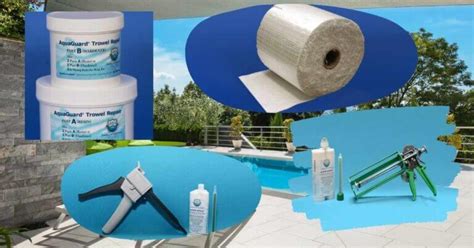How To Repair Fibreglass Pool
Ronan Farrow
Apr 02, 2025 · 4 min read

Table of Contents
How to Repair Fiberglass Pool: A Comprehensive Guide
Maintaining a sparkling, inviting fiberglass pool is a homeowner's dream. However, even the most durable fiberglass pools can suffer from minor damage over time. From small chips and cracks to more substantial damage, knowing how to repair fiberglass pools effectively is crucial for preserving its beauty and extending its lifespan. This comprehensive guide will equip you with the knowledge and steps to tackle various fiberglass pool repairs, saving you money and keeping your pool in top condition.
Assessing the Damage: The First Step to Repair
Before diving into repairs, a thorough assessment of the damage is vital. This allows you to choose the right approach and materials for the job. Consider these key factors:
Severity of the Damage:
- Minor Chips and Scratches: These superficial imperfections usually only affect the gel coat and are the easiest to fix.
- Cracks: Cracks can range from hairline fractures to larger, more significant breaks. The depth and length of the crack will determine the repair complexity.
- Holes: Holes require more extensive repair, often needing patching materials to fill the void.
Location of the Damage:
The location of the damage will impact the repair method. Damage near the waterline might be exposed to more frequent wear and tear, requiring a more durable repair.
Type of Damage:
Understanding whether the damage is purely cosmetic or involves structural compromise is crucial. Small chips are usually cosmetic, while large cracks might compromise the pool's structural integrity.
Repairing Minor Chips and Scratches
For minor imperfections like chips and scratches, a simple repair can often restore the pool's pristine appearance.
Materials You'll Need:
- Fine-grit sandpaper: For smoothing rough edges.
- Fiberglass repair kit: Containing resin and hardener.
- Putty knife or small spatula: For applying the repair compound.
- Clean cloths: For wiping away excess resin.
- Gel coat matching your pool's color: For restoring the finish (optional).
Repair Process:
- Clean the area: Thoroughly clean the damaged area with a degreaser to remove any dirt, oil, or debris. Allow it to dry completely.
- Sand the edges: Gently sand the edges of the chip or scratch to create a smooth, even surface.
- Mix the resin: Follow the manufacturer's instructions for mixing the resin and hardener from your fiberglass repair kit.
- Apply the resin: Use a putty knife or spatula to apply a thin layer of the mixed resin to the damaged area.
- Allow to cure: Let the resin cure completely, as specified by the manufacturer's instructions. This usually takes several hours.
- Sand and polish (Optional): Once cured, you may need to sand the repaired area smooth and then apply a matching gel coat for a flawless finish.
Repairing Cracks and Holes
Larger cracks and holes require a more robust repair process. This often involves using a patching material in addition to resin and hardener.
Materials You'll Need:
- Fiberglass mat or cloth: For reinforcement.
- Epoxy resin: A stronger adhesive than polyester resin.
- Marine-grade putty: For filling larger holes.
- Additional sanding materials: For smoothing larger repairs.
Repair Process:
- Clean and prepare: Thoroughly clean and dry the damaged area. For cracks, widen them slightly to ensure proper penetration of the resin.
- Apply the patching material: Use marine-grade putty or a fiberglass mat to reinforce the damaged area. Apply multiple layers if necessary.
- Apply epoxy resin: Apply epoxy resin over the patching material to ensure a strong bond.
- Cure and sand: Allow the epoxy to cure completely before sanding the repaired area smooth.
- Apply gel coat (optional): If needed, apply a matching gel coat for a seamless finish.
Prevention is Key: Maintaining Your Fiberglass Pool
While repairs are sometimes necessary, proactive maintenance can significantly reduce the likelihood of damage.
- Regular cleaning: Regularly clean your pool to remove debris and prevent staining.
- Proper water chemistry: Maintaining proper water chemistry prevents corrosion and damage to the pool's surface.
- Careful use: Avoid dragging sharp objects across the pool's surface.
By following these steps and incorporating preventative measures, you can keep your fiberglass pool looking its best for years to come. Remember, if you are unsure about any repair, it's always best to consult a professional pool repair company.
Featured Posts
Also read the following articles
| Article Title | Date |
|---|---|
| How To Ship Bagels | Apr 02, 2025 |
| How To Strap Dirt Bike In Truck | Apr 02, 2025 |
| How To Read Bike Odometer | Apr 02, 2025 |
| How To Reheat A Funnel Cake | Apr 02, 2025 |
| How To Shoot A Skunk Without It Spraying | Apr 02, 2025 |
Latest Posts
-
How Can I Find Out If A Motorcycle Is Stolen
Apr 03, 2025
-
How Can I Boost My Cell Signal In Rural Areas
Apr 03, 2025
-
How Can I Block Facebook On My Phone
Apr 03, 2025
-
How Can I Become A Midwife Assistant
Apr 03, 2025
-
How Can I Avoid Paying Nj Exit Tax
Apr 03, 2025
Thank you for visiting our website which covers about How To Repair Fibreglass Pool . We hope the information provided has been useful to you. Feel free to contact us if you have any questions or need further assistance. See you next time and don't miss to bookmark.
